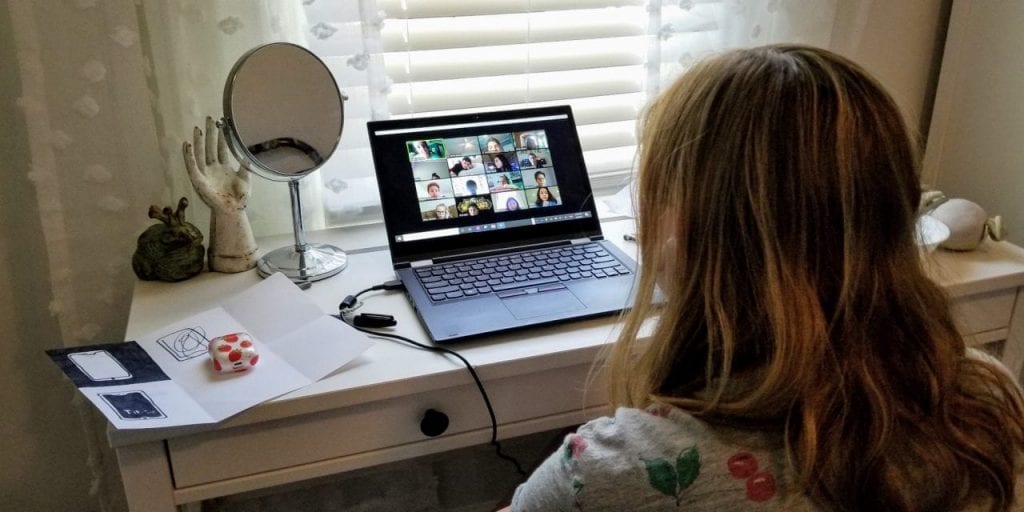While weather conditions have provided the occasional opportunity to experiment with virtual learning days, those brief interludes of remote learning pale in comparison to the scope of our current enterprise. It’s one thing to be closed for a few days during a snowstorm, and quite another to be shut down for weeks at a time in the midst of a global health crisis.
Cary Academy is fortunate to be entering into this unprecedented period of nationwide school closures with a distinct advantage when it comes to access to and comfort with technology. Whether it’s working in a OneNote notebook, editing a shared document, contributing to a discussion board, using an online interface to practice a musical instrument or a second language, exploring a math concept with a digital visualization tool, generating an infographic, recording a podcast, producing a video, creating a digital slideshow, Skyping with an outside expert, or doing 10 minutes of Membean, our faculty and our students are already quite accustomed to using technology in many and varied ways to support learning and growth.
Normally, however, the robust program of technology-infused learning that is business-as-usual at Cary Academy would be embedded in a strong framework of daily in-person interactions. How can we maintain that sense of human connection that is so critical to learning and wellbeing when everyone is suddenly working in isolation from home? The challenge facing our school with the closure of our campus is arguably less about a shift to digital learning than a shift to distance learning.
Our first two weeks of virtual learning have been all about figuring out how best to bridge the distance that has become our new normal (at least for now) and continue to provide mission-centered learning experiences that include opportunities for social interaction and feedback. Our general approach to virtual learning in this start-up phase has been to begin with the familiar, and then gradually phase in new procedures and tools, trying hard not to overwhelm anyone in the process.
As part of the transition to virtual learning, faculty and students have been learning to use two new platforms that support live communication in an online setting: Microsoft Teams and Zoom Meetings. The video conferencing, screensharing and chat features of these platforms are helping us to recreate the sense of in-person connection that is vital to student engagement.
While video conferencing is certainly an important new tool in our virtual learning toolkit, we are in no way looking to replicate our normal daily schedule as a series of video meetings. Expecting teachers and students to stare at their screens in that way is neither healthy nor representative of the kind of active learning that students enjoy when school is in regular session. Our virtual learning schedule is instead designed to provide time for a combination of synchronous and asynchronous learning activities, with individual teachers balancing these two modes from week to week in a way that makes sense for the specific learning goals they have identified for their students.
Understandably, the main focus during our first two weeks of virtual learning has been upon getting our academic classes up and running. The way faculty have jumped into the difficult work of relaunching their classes in the digital environment and creating a sense of connection for students, and the positive way students and parents have responded to these efforts, have been remarkable and inspiring.
The shift to online learning has, of course, required us to pare down our curriculum–focusing on our most essential learning objectives for students and adjusting our time and product expectations accordingly. This is one of those occasions where less is more, and honing in on key concepts and skills will take us further than trying to pack everything we had planned for a regular trimester into our necessarily condensed virtual school schedule.
Happily, we have now reached a point in our virtual learning journey where we are ready to begin layering in additional opportunities for students to engage with their teachers and their peers. We have built time into the schedule for advisory and for club meetings, and we are looking at other ways we might work with students and families to recapture a feeling of connectedness in the virtual realm.
At the same time, we are keenly aware that there is a learning curve for faculty in redesigning their classes for a virtual learning environment, and we have to give them the time they need to rethink their curricula and reshape their instructional strategies for the online setting. We are equally mindful of the fact that we are all caught in a difficult situation right now, and there are limits to what we can reasonably ask of our employees and our families in the current climate of uncertainty and disruption. Our virtual learning schedule reflects these considerations, as well.
Distance is a tough hurdle, made even tougher by the physical, emotional and financial stress that is all around us. That said, if we all continue to approach our current situation with creativity, flexibility, and compassion for one another, we will have a spring trimester of virtual learning that we can all be proud of.

